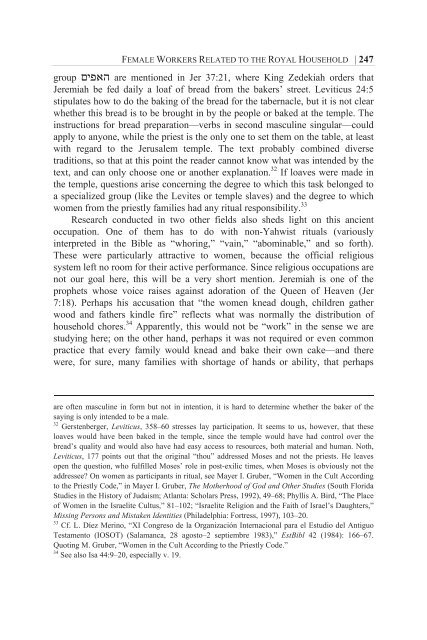Women at Work in the Deuteronomistic History - International Voices ...
Women at Work in the Deuteronomistic History - International Voices ...
Women at Work in the Deuteronomistic History - International Voices ...
You also want an ePaper? Increase the reach of your titles
YUMPU automatically turns print PDFs into web optimized ePapers that Google loves.
FEMALE WORKERS RELATED TO THE ROYAL HOUSEHOLD | 247<br />
group םיפאה are mentioned <strong>in</strong> Jer 37:21, where K<strong>in</strong>g Zedekiah orders th<strong>at</strong><br />
Jeremiah be fed daily a loaf of bread from <strong>the</strong> bakers’ street. Leviticus 24:5<br />
stipul<strong>at</strong>es how to do <strong>the</strong> bak<strong>in</strong>g of <strong>the</strong> bread for <strong>the</strong> tabernacle, but it is not clear<br />
whe<strong>the</strong>r this bread is to be brought <strong>in</strong> by <strong>the</strong> people or baked <strong>at</strong> <strong>the</strong> temple. The<br />
<strong>in</strong>structions for bread prepar<strong>at</strong>ion—verbs <strong>in</strong> second mascul<strong>in</strong>e s<strong>in</strong>gular—could<br />
apply to anyone, while <strong>the</strong> priest is <strong>the</strong> only one to set <strong>the</strong>m on <strong>the</strong> table, <strong>at</strong> least<br />
with regard to <strong>the</strong> Jerusalem temple. The text probably comb<strong>in</strong>ed diverse<br />
traditions, so th<strong>at</strong> <strong>at</strong> this po<strong>in</strong>t <strong>the</strong> reader cannot know wh<strong>at</strong> was <strong>in</strong>tended by <strong>the</strong><br />
text, and can only choose one or ano<strong>the</strong>r explan<strong>at</strong>ion. 32 If loaves were made <strong>in</strong><br />
<strong>the</strong> temple, questions arise concern<strong>in</strong>g <strong>the</strong> degree to which this task belonged to<br />
a specialized group (like <strong>the</strong> Levites or temple slaves) and <strong>the</strong> degree to which<br />
women from <strong>the</strong> priestly families had any ritual responsibility. 33<br />
Research conducted <strong>in</strong> two o<strong>the</strong>r fields also sheds light on this ancient<br />
occup<strong>at</strong>ion. One of <strong>the</strong>m has to do with non-Yahwist rituals (variously<br />
<strong>in</strong>terpreted <strong>in</strong> <strong>the</strong> Bible as “whor<strong>in</strong>g,” “va<strong>in</strong>,” “abom<strong>in</strong>able,” and so forth).<br />
These were particularly <strong>at</strong>tractive to women, because <strong>the</strong> official religious<br />
system left no room for <strong>the</strong>ir active performance. S<strong>in</strong>ce religious occup<strong>at</strong>ions are<br />
not our goal here, this will be a very short mention. Jeremiah is one of <strong>the</strong><br />
prophets whose voice raises aga<strong>in</strong>st ador<strong>at</strong>ion of <strong>the</strong> Queen of Heaven (Jer<br />
7:18). Perhaps his accus<strong>at</strong>ion th<strong>at</strong> “<strong>the</strong> women knead dough, children g<strong>at</strong>her<br />
wood and f<strong>at</strong>hers k<strong>in</strong>dle fire” reflects wh<strong>at</strong> was normally <strong>the</strong> distribution of<br />
household chores. 34 Apparently, this would not be “work” <strong>in</strong> <strong>the</strong> sense we are<br />
study<strong>in</strong>g here; on <strong>the</strong> o<strong>the</strong>r hand, perhaps it was not required or even common<br />
practice th<strong>at</strong> every family would knead and bake <strong>the</strong>ir own cake—and <strong>the</strong>re<br />
were, for sure, many families with shortage of hands or ability, th<strong>at</strong> perhaps<br />
are often mascul<strong>in</strong>e <strong>in</strong> form but not <strong>in</strong> <strong>in</strong>tention, it is hard to determ<strong>in</strong>e whe<strong>the</strong>r <strong>the</strong> baker of <strong>the</strong><br />
say<strong>in</strong>g is only <strong>in</strong>tended to be a male.<br />
32 Gerstenberger, Leviticus, 358–60 stresses lay particip<strong>at</strong>ion. It seems to us, however, th<strong>at</strong> <strong>the</strong>se<br />
loaves would have been baked <strong>in</strong> <strong>the</strong> temple, s<strong>in</strong>ce <strong>the</strong> temple would have had control over <strong>the</strong><br />
bread’s quality and would also have had easy access to resources, both m<strong>at</strong>erial and human. Noth,<br />
Leviticus, 177 po<strong>in</strong>ts out th<strong>at</strong> <strong>the</strong> orig<strong>in</strong>al “thou” addressed Moses and not <strong>the</strong> priests. He leaves<br />
open <strong>the</strong> question, who fulfilled Moses’ role <strong>in</strong> post-exilic times, when Moses is obviously not <strong>the</strong><br />
addressee? On women as participants <strong>in</strong> ritual, see Mayer I. Gruber, “<strong>Women</strong> <strong>in</strong> <strong>the</strong> Cult Accord<strong>in</strong>g<br />
to <strong>the</strong> Priestly Code,” <strong>in</strong> Mayer I. Gruber, The Mo<strong>the</strong>rhood of God and O<strong>the</strong>r Studies (South Florida<br />
Studies <strong>in</strong> <strong>the</strong> <strong>History</strong> of Judaism; Atlanta: Scholars Press, 1992), 49–68; Phyllis A. Bird, “The Place<br />
of <strong>Women</strong> <strong>in</strong> <strong>the</strong> Israelite Cultus,” 81–102; “Israelite Religion and <strong>the</strong> Faith of Israel’s Daughters,”<br />
Miss<strong>in</strong>g Persons and Mistaken Identities (Philadelphia: Fortress, 1997), 103–20.<br />
33 Cf. L. Díez Mer<strong>in</strong>o, “XI Congreso de la Organización Internacional para el Estudio del Antiguo<br />
Testamento (IOSOT) (Salamanca, 28 agosto–2 septiembre 1983),” EstBibl 42 (1984): 166–67.<br />
Quot<strong>in</strong>g M. Gruber, “<strong>Women</strong> <strong>in</strong> <strong>the</strong> Cult Accord<strong>in</strong>g to <strong>the</strong> Priestly Code.”<br />
34 See also Isa 44:9–20, especially v. 19.




